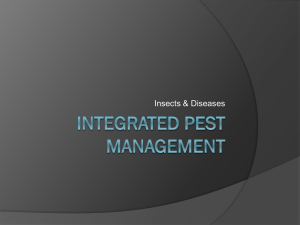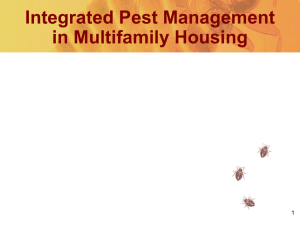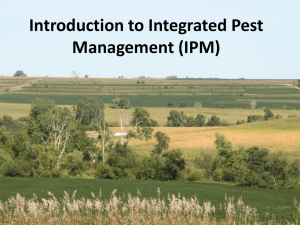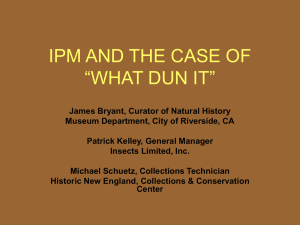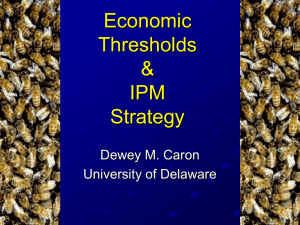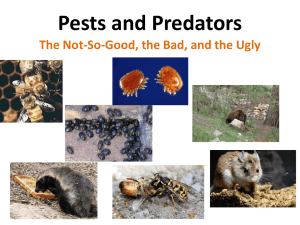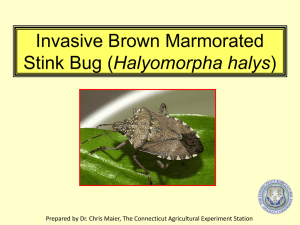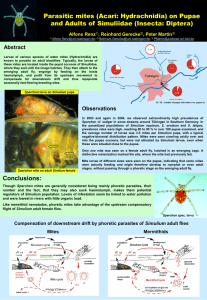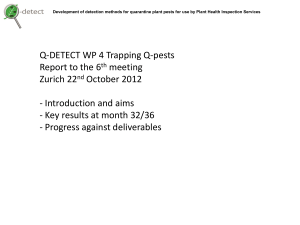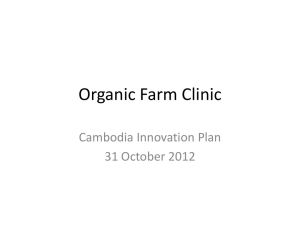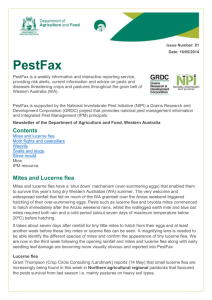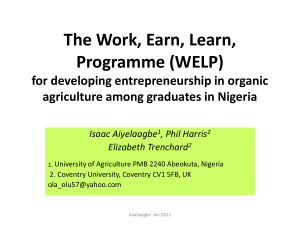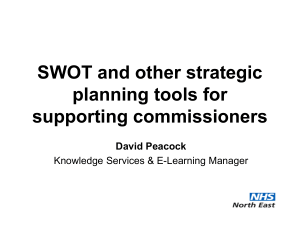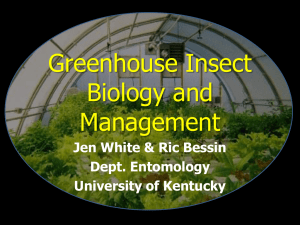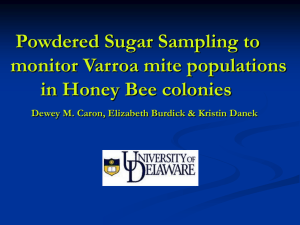MG13 Vegetable IPM - University of Maryland Extension
advertisement
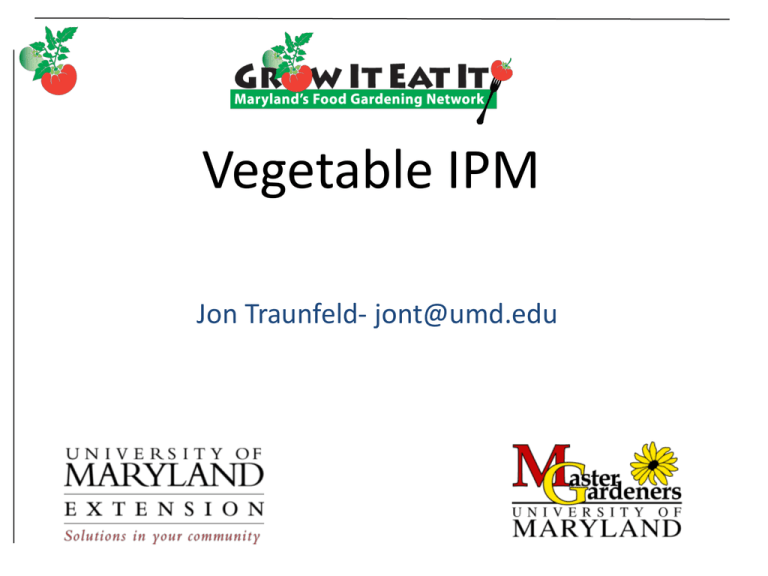
Vegetable IPM Jon Traunfeld- jont@umd.edu College of Agriculture and Natural Resources PART 1 An overview of Integrated Pest Management Principles and Practices Vegetable IPM • Gardeners want to reduce dependence on pesticides that pose risks to people, nonhuman animals, and natural resources. • The way you garden and manage pests can affect my garden. • We need an ecosystem approach that emphasizes non-chemical strategies for pest management. IPM philosophy • IPM is a knowledge-based, wholistic approach to managing pests at an acceptable level. • Gardens, and landscapes are complex ecosystems; IPM seeks balance between pests and beneficials. • Emphasizes biological, cultural, and physical methods to prevent and manage problems. Least toxic pesticides may be warranted as a last resort. IPM: simple steps and common sense “Study” – “right plant in the right place”; give them what they need. – know the important pest problems and how to prevent them. – learn the habits, life-cycle, and weaknesses of key pests. “Spy” – monitor plants closely for signs and symptoms of problems. Are symptoms getting worse? – strive for correct diagnosis of problem. “Squish” – take “least toxic” action. – did the action work? Continue to monitor. Cultural and Environmental Abiotic = “without life” Problems • • Less than ½ of plant problems are caused by insects, disease, and other critters •Blossom-end rot (nutritional disorder) “Catfacing”caused by planting too early. 2,4-D herbicide injury Plants burned with pyrethrum and soap insecticide Knowledge: hornworm lifecycle Mexican Bean Beetle- “Skeletonizer” Emerging Pests: squash beetle Biological control • Give mother nature a chance! – Predators eat pests – Parasitoids lay their eggs on or in pests Biological Control • Attracting natural, native predators and parasites. Plant beds of flowering annuals and perennials in these families: – – – – Mint (anise hyssop, thyme Carrot (dill, yarrow) Aster (tansy, marigold, zinnia) Brassica (alyssum, dames rocket, Asian greens) • Buying and releasing predators and parasites – not generally recommended because they tend to disperse; effectiveness varies – ok for severe spider mites infestations Food for our garden buddies • Many predators and parasites require nectar and pollen at some point in their life cycle. • Plant… mountain mint, anise hyssop, thyme, oregano, basil, dill, yarrow, aster, zinnia, alyssum, phlox, bee balm, milkweeds, butterfly weed, borage, lamb’s ear Natural predators Hornworm parasitized by tiny Braconid wasps Wasps- 220; hornworm- 1 Photo: Rosemary Noble Bio-control of aphids Physical control strategies • Hand-pick pest insects and their egg masses. • Remove badly diseased leaves or plants. • Exclude insects and other pests with a floating row cover, fence, etc. • Apply a barrier dust or spray- wood ash, lime, kaolin clay to prevent insect feeding. Your mission: locate and destroy egg masses Colorado potato beetle Squash bug Floating row cover • Spun-bonded polyester; gauzy material. Draped over crop and secured to ground; leave slack to allow crop growth. • Excludes pests, and increases crop growth in spring and fall by raising temp. and humidity. • Can be re-used; must be removed before flowering of cross-pollinated crops (cukes, squash, etc.) Row cover – flea beetles = healthy eggplant Flea Beetles Eggplant Leaves Coated with Surround Surround- kaolin clay • 2006 research shows flea beetle supression- may be effective with other pests • About $1 per lb. Rate: 1 cup/1 qt. water • Spray when leaves are dry. Apply thoroughly to all leaf surfaces. • Maintain white film coating on leaves; may take 2-3 applications. Re-apply if rainfall washes off white coating. • Can be used up to the date of harvest. Cultural control strategies • Grow resistant varieties • Clean up and compost plant debris at end of season • Time your crops to avoid expected pests • Prune out injury; bag up badly infested plants • Plant lots of flowering plants to attract beneficial insects Some effective organic pesticides • Pyrethrins- controls or suppresses a wide range of insects (Pyganic- 1.4%) • Neem extract – suppresses beetles and caterpillars • Neem oil- insecticide and preventative fungicide • Spinosad- controls beetles, caterpillars, flies, thrips • Bacillus thuringiensis- controls young caterpillars; suppresses large caterpillars Other good organic pesticides • Hort oil- controls aphids, mites, soft-bodied immatures • Insecticidal soap- suppresses aphids, mites, soft-bodied immatures • Copper- fungicide Spinosad • Derived from Saccharopolyspora spinosa, a soil bacterium. • Causes rapid excitation of nervous system. • Must be ingested; kills within 2 days • Effective against caterpillars, beetles, sawflies, leafhoppers, spider mites; BUT NOT true bugs • Most beneficials not harmed • Monterey, Ferti-Lome, and Bonide have home garden products PART 2 Some of the Common Insect Pests and Diseases of Concern Spider mites love it hot and dry Spider mites Spider Mites • 8 legged, non-insect; active on leaf undersides. Two-spotted and European red are primary pest species. • Sucking mouthparts produce “stipples”; tiny bleached areas on leaf surface; leaves yellow and die • Webbing is a sign of severe infestation • Wide host range; many vegetable plants • Thrive in hot, dry weather • Many quick generations each year Organic Management • Mites like it hot, dry, and dusty. Hose off plants to dislodge and repel mites. • Horticulural oil and insecticidal soap is most effective on eggs. May be used if leaves are not too damaged or hot to tolerate it. • Excessive nitrogen fertilization increases mites • Mites will migrate from neighboring weeds, so keep weeds supressed. Clean up garden residues. Squash bug Eggs and immatures Organic management • Remove plant debris to eliminate overwintering sites. • Hand-pick adults and eggs; trap with wooden boards. • Cover plants with floating row cover from transplant to bloom. • Plant late (mid-June); plant successive crops. Squash bug parasitoid Wilted squash- what could be wrong? Squash vine borer Squash vine borer • Very common lethal pest; attacks squashes and pumpkin. • Pupae over-winter below soil; moths emerge in spring and inconspicuous eggs are laid singly on stems. • Cream colored larva with brown head; 1 inch long when mature. • 1-2 generations/year. Organic management: before signs of injury • Set out 3-4 week old transplants after danger of frost to get a jump on this pest. • Cover plants with floating row cover until flowering to prevent egg-laying. • Dust lower stems with rotenone or pyrethrum or wrap them with aluminum foil. • Till soil at season’s end to kill/expose svb cocoons. • Butternut and cushaw are resistant; yellow crookneck less susceptible than zucchini. Organic management: after signs of injury • Locate active borers by slitting the vine vertically where frass is kicked out. Kill borer. Mound soil over the wound or wrap with duct tape. • Seal up infested vines in plastic bag before larvae pupate (break life cycle.) Imported cabbageworm Imported cabbageworm • Pupa overwinter in chrysalis; emerge as butterflies in spring; strong fliers • Eggs are rarely noticed • 2-3 generations; early control is essential • Host plants are all in cabbage family Cotesia glomerata- parasitoid Organic management • Remove all cabbage family crop residues when crops are finished • Floating row cover for planting to harvest • Hand-pick larvae • Spray with Bt or Spinosad Spotted cucumber beetle Striped cucumber beetle Bacterial Wilt Disease bacterial ooze Organic Management • Difficult to hand-pick; must be controlled early in season. • Exclude with floating row cover. • Protect plants prior to flowering with organic insecticides (apply to both sides of leaves). • Seal up badly infested plants in plastic bag. • Plant late; plant multiple crops. Harlequin bug Harlequin bug nymphs hatching from eggs Organic management • Once or twice a week- search out and crush eggs, nymphs, and adults. • Floating row cover from transplant to harvest. • Spray nymphs with an pyrethrum + oil/soap or neem + oil/soap (spray must contact bugs). • Mustard greens and Chinese cabbage are most vulnerable crops. • Remove all crop residues when crops are finished (if composting- make sure piles reach 140 degrees F. to kill bugs). • This can become a major pest if you continually grow cabbage family crops. Native stink bugs Brown stink bug nymph Green stink bug nymph Southern green stink bug nymph Brown and Green Stink Bug and Fruit Injury BMSB feeds on many fruits & vegetables http://www.agnr.umd.edu/news/article.cfm?id=fd26661f0a5a5a8f00985fc62735924d Brown marmorated stink bug meats Godzilla! Egg mass with 1st and 2nd instar nymphs Each instar is one week 2nd instar looks like tiny spiders or ticks Photo by Gary Bernon, USDA_APHIS 2nd to 5th instar USDA ARS Common fungal diseases of tomato leaves… Septoria leaf spot Early blight Advanced symptoms of early blight Early blight and Septoria leaf spot • Principal foliar diseases of tomato. • Splashes up to lower leaves and progresses up plant. • First symptom of early blight is irregular brown lesions with bulls-eye pattern and yellow halo. Septoria spots are small and light in color with dark margins. • Can spread rapidly with warm, humid weather and defoliate plants. • Over-winters in crop debris, wooden stakes, and in soil. Organic management • Cultivars vary somewhat in susceptibility; but none with good resistance. • Thick organic mulch can slow upward splashing of fungal spores. • Give plants more space; improved air circulation. • Remove badly infected lower leaves. • Spray with fixed copper fungicide; other organic sprays have not proven effective . Key points to remember… • It’s easier to prevent a problem than cure one. • Look under leaves for pest problems. • Insect pests are more vulnerable to pesticides in their larval stage. • Never spray insecticides during bloom period. Resources • Grow It! Eat It! http://www.extension.umd.edu/growit – We have all types of practical food gardening tips and information. Check out our popular blog! • Home and Garden Information Center http://www.extension.umd.edu/hgic – Here you will find factsheets, photos, and videos. You can also subscribe to the free monthly e-newsletter. – We answer gardening questions 24/7…just click “Ask Maryland’s Garden Experts” • Maryland Master Gardener Program http://www.extension.umd.edu/mg – Consider becoming a trained MG volunteer! This program was brought to you by the Maryland Master Gardener Program Howard County University of Maryland Extension
